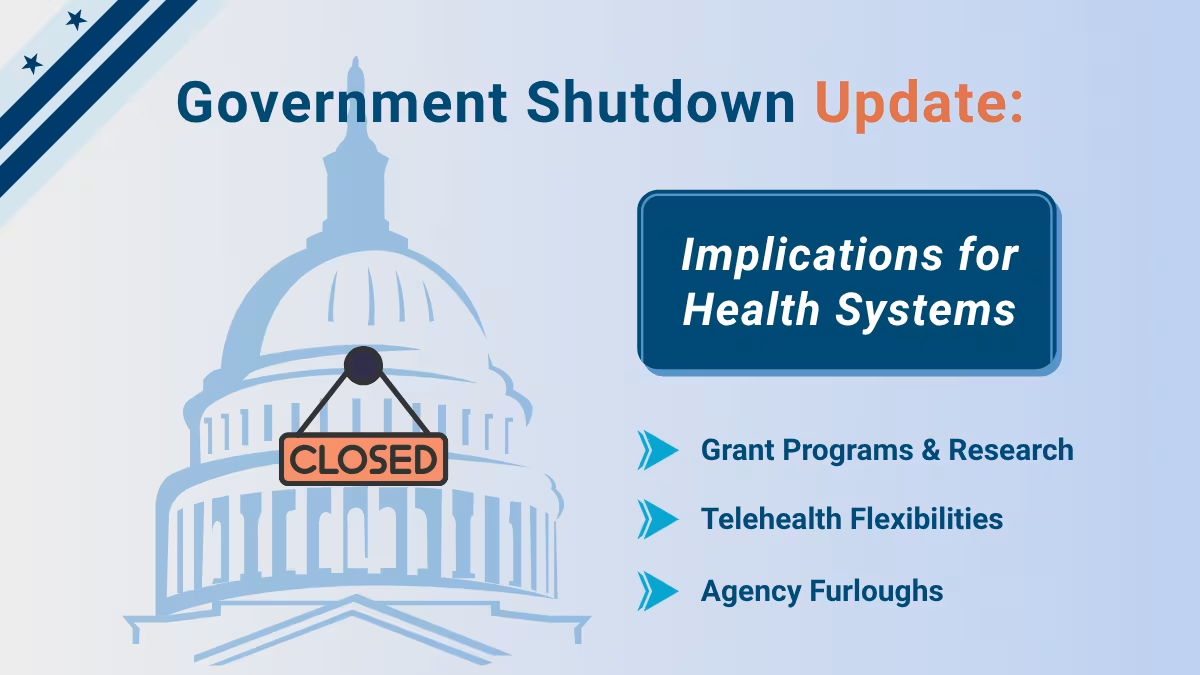On Oct. 1, the federal government shut down after Congress failed to pass new funding legislation. With lawmakers deadlocked, many expect the shutdown to last for weeks: according to odds on the prediction market Kalshi, bettors give even odds that the shutdown will stretch beyond 25 days.
Proposals to fund and reopen the government have stalled in the Senate, where Republicans need at least some Democratic votes to overcome the 60-vote filibuster threshold. Congressional Democrats say they’ll refuse to back any legislation that doesn’t extend enhanced subsidies for ACA marketplace plans.
The federal shutdown has wide-ranging impacts for health systems:
ACA subsidies: If enhanced subsidies are not extended, individual marketplace premiums are expected to rise by 114%, according to an estimate by the Kaiser Family Foundation. The Congressional Budget Office estimates that 3.8M additional Americans would forgo coverage altogether without the subsidies in place.
Telehealth flexibilities: Medicare flexibilities enacted during the pandemic waiving geographic, originating site, and modality restrictions expired on Oct. 1. CMS confirmed that the previous restrictions would resume and said providers could hold off on submitting claims for now.
The American Telemedicine Association sent letters to President Trump and congressional leaders urging them to reinstate flexibilities and give retroactive reimbursement to providers that offer virtual care during the shutdown.
Hospital-at-Home: Waivers enabling Medicare reimbursement for H@H patients also expired on Oct. 1, and CMS has instructed participating hospitals to discharge or return patients to brick-and-mortar inpatient facilities.
DSH and rural add-on payments: The shutdown coincides with the scheduled $8 billion cut to Medicaid disproportionate-share hospital (DSH) payments and expiration of rural add-on programs, threatening safety-net and critical-access hospitals that rely on these supplemental funds to stay solvent.
Agency furloughs: Thousands of staff at HHS, CDC, FDA, and CMS are furloughed. This slows or halts regulatory reviews, inspections, data releases, and public-health surveillance, while essential functions (like outbreak response and drug safety monitoring) continue with minimal staffing.
More than 150K federal employees are also leaving the government after accepting buyouts.
Grant programs and research: NIH and HRSA have paused most grant reviews and new awards. Ongoing studies, community-health initiatives, and innovation projects face delays or temporary shutdowns as federal payments are suspended.
Workforce training: Federal support for health-care workforce and residency programs (such as Title VII and VIII training grants and the National Health Service Corps) is frozen, slowing hiring and pipeline development at teaching hospitals and clinics.
It’s also important to note what’s not affected:
Medicare, Medicaid, and Social Security: These mandatory entitlement programs continue to pay benefits and process claims, though customer-service lines and administrative appeals may face delays due to limited staffing.
Surprise billing arbitration: The independent dispute-resolution system created under the No Surprises Act continues operating because it is funded through user fees collected from insurers and providers, not annual appropriations.
So What?
In the short term, health systems face disrupted operations and financial losses from halted reimbursement and expired programs. In the longer term, the shutdown raises existential questions about health systems’ reliance on federal dollars and their participation in programs vulnerable to partisan fights in Washington.
We have a few thoughts on the response playbook for health system strategists:
1. Scenario planning and stress testing are key tools for strategic planning
Health systems that don’t proactively plan for federal shutdowns are flying blind when disruptions occur. The current shutdown is a crisis, but it’s also an opportunity to learn how your system copes with disruptions in federal support.
Congressional lawmakers routinely threaten to shut down the government as part of their yearly spending negotiations, and this year marks the fourth actual shutdown in the past 20 years. At this point, there’s no excuse to not be prepared.
First and foremost, organizations need to fortify their financial position by monitoring cash reserves, securing lines of credit, optimizing revenue cycle operations, keeping open lines of communication with key vendors and landlords, and developing a prioritized payment plan to conserve cash for essential obligations.
2. Resilience should be built into program design
Many of the key programmatic expirations (telehealth flexibilities, H@H waivers) were anticipated far in advance, and the most prepared systems have built their programs around this possibility.
For example, earlier this year, we wrote about how some top-performing H@H programs worked with commercial payers to expand services that fall outside of the federal program’s umbrella (e.g., SNF, palliative care, and oncology at home) as a way to hedge their bets. Along similar lines, some providers created contingency plans for the expiration of telehealth authorities that involved proactive communication with patients and collaboration with nearby brick-and-mortar providers.
3. Communication is key
With patients, keep messages simple and steady: what’s open, what’s changing, and what alternatives exist if telehealth or subsidies lapse. Clear updates through portals and texts calm confusion and keep trust.
With providers, consistent internal updates prevent mixed signals on billing, coverage, and compliance. Equip front-line staff with answers and keep clinicians looped in on contingency plans.
And with policymakers, coordinated advocacy matters. Tell the real stories of lost access and disrupted care. Credible voices on the ground carry weight.
